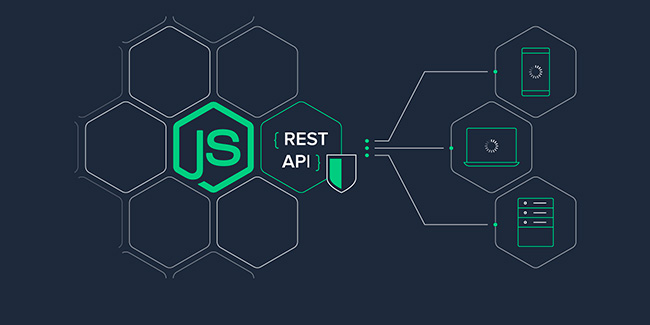

Node.js REST API: Top Five Architectures You Need To Know About


At Introduct Group, we understand that at the very heart of any successful digital solution comes the need to choose the appropriate architecture. While building REST APIs with Node.js, the architecture selected is the backbone for your application’s scalability, maintainability, and performance. With so many alternatives available today, it becomes vital to select an architecture best suited to meet the project’s particular needs and long-term aims.
In this article, we’re going to explore the top five architectures for building REST APIs with Node.js, providing insights to help you make an informed decision.
MVC (Model-View-Controller) Architecture
The MVC architecture is a well-known design pattern that organizes application code into distinct layers. Although often associated with web applications, MVC can be effectively adapted for REST APIs, ensuring a clean separation of concerns.
- Model: Manages the data and business logic.
- View: Not utilized in REST APIs, as the API only returns data.
- Controller: Processes input, interacts with the model, and returns the output.
Example Structure:
my-app/
├── controllers/
│ └── userController.js
├── models/
│ └── userModel.js
├── routes/
│ └── userRoutes.js
├── app.js
└── server.js
Using MVC allows for better code organization, making your API easier to maintain and scale as your business grows.
Service-Oriented Architecture (SOA)
Service-Oriented Architecture (SOA) divides your application into distinct services, each dedicated to a specific function. This modular approach enhances the separation of concerns and simplifies both testing and development.
- Services: Encapsulate business logic.
- Controllers: Manage requests and responses, invoking the relevant services.
- Routes: Define endpoints and map them to controllers.
Example Structure:
my-app/
├── services/
│ └── userService.js
├── controllers/
│ └── userController.js
├── routes/
│ └── userRoutes.js
├── app.js
└── server.js
SOA is ideal for projects requiring modularity, allowing different teams to develop and maintain distinct services independently.
Microservices Architecture
Microservices architecture further modularizes applications into small, independent services. Every service runs in its own process and communicates via HTTP or other protocols. This makes this architecture very suitable for complex and large-scale projects. If you want to know more about microservices, read ourarticle.
- Microservices: Each service contains its own controller, model, and routes.
- API Gateway: Manages incoming requests, routing them to the appropriate microservice.
Example Structure:
user-service/
├── controllers/
│ └── userController.js
├── models/
│ └── userModel.js
├── routes/
│ └── userRoutes.js
├── app.js
└── server.js
order-service/
├── controllers/
│ └── orderController.js
├── models/
│ └── orderModel.js
├── routes/
│ └── orderRoutes.js
├── app.js
└── server.js
api-gateway/
└── server.js
Microservices architecture provides flexibility, enabling teams to deploy, scale, and update services independently, ensuring your application can evolve with your business.
Serverless Architecture
In a serverless architecture, cloud services handle your API functions on demand, offering scalability and cost efficiency, especially for applications with variable loads.
- Functions: Each function handles a specific endpoint or piece of logic.
- API Gateway: Manages endpoints, directing traffic to the appropriate functions.
Example Structure:
functions/
├── createUser.js
├── getUser.js
├── updateUser.js
└── deleteUser.js
serverless.yml
This architecture minimizes infrastructure management, allowing your team to focus on delivering value through code, while cloud services manage the rest.
Hexagonal Architecture (Ports and Adapters)
Hexagonal architecture, also known as Ports and Adapters, ensures your core logic remains isolated from external factors. This structure enhances testability and makes it easier to adapt to future changes without disrupting the core business logic.
- Adapters: Handle input and output, such as controllers for HTTP requests.
- Ports: Interfaces that define the core logic.
- Domain: Encapsulates the core business logic.
Example Structure:
my-app/
├── adapters/
│ └── http/
│ ├── controllers/
│ │ └── userController.js
│ └── routes/
│ └── userRoutes.js
├── domain/
│ ├── models/
│ │ └── user.js
│ └── services/
│ └── userService.js
├── ports/
│ └── userPort.js
├── app.js
└── server.js
Hexagonal architecture is perfect for projects that demand a clear separation between business logic and technical implementation, allowing for easier integration and updates over time.
Conclusion
Each architecture offers distinct benefits, designed to meet a variety of project needs and complexities. Whether your focus is on the modularity of microservices, the efficiency of serverless, or the straightforwardness of MVC, Node.js provides the flexibility required to build strong, effective REST APIs that align with your business goals.
At Introduct Group, we leverage our expertise in Node.js and the latest technologies to help you select and implement the architecture that best suits your project. Our goal is to turn your ideas into impactful solutions, ensuring that your REST APIs are built on a reliable and scalable foundation.
Let’s collaborate to bring your vision to life with the most suitable architectural strategy.
More Articles

Genkit for Go: Your Path to Advanced AI Applications Genkit for Go: Your Path to Advanced AI Applications
Genkit for Go is an open-source framework designed to empower Go developers in building AI applications and cloud services. Moreover, this collaboration between the Firebase and Go teams combines Go’s simplicity, scalability, and security with Genkit’s robust libraries and tools. At Introduct, a progressive IT company committed to innovation, we are excited to explore this […]

Elixir vs Golang: Choosing the Right Language for Gaming Platforms Elixir vs Golang: Choosing the Right Language for Gaming Platforms
GoLang or Elixir? When it comes to developing gaming platforms, the choice of programming language can significantly impact performance, scalability, and development speed. In this blog post, we’ll compare two popular languages, Elixir and Golang, and explore their suitability for building gaming platforms.
